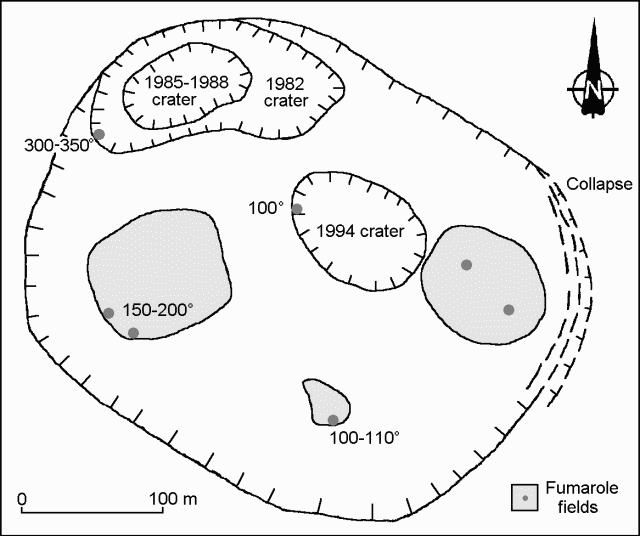Report on Telica (Nicaragua) — March 1997
Bulletin of the Global Volcanism Network, vol. 22, no. 3 (March 1997)
Managing Editor: Richard Wunderman.
Telica (Nicaragua) Seismicity increases and fumarolic activity continues
Please cite this report as:
Global Volcanism Program, 1997. Report on Telica (Nicaragua) (Wunderman, R., ed.). Bulletin of the Global Volcanism Network, 22:3. Smithsonian Institution. https://doi.org/10.5479/si.GVP.BGVN199703-344040
Telica
Nicaragua
12.606°N, 86.84°W; summit elev. 1036 m
All times are local (unless otherwise noted)
On 27 February, during a visit to the summit crater, scientists noted continuing minor fumarolic activity with maximum temperatures of 300-350°C and an active collapse zone on the E crater rim (figure 10). At this time a portable seismic station recorded microearthquakes at 30-40 minute intervals. Night observations of the crater confirmed the absence of any incandescence.
 |
Figure 10. Sketch of the active crater at Telica indicating areas of fumarolic activity. Temperature is degrees C. Courtesy of Alain Creusot. |
During March 1997, seismicity was high with about 150 seismic signals/day recorded. Seismicity levels increased from December 1996, when there were less than 100 signals/day. Most March events had frequencies of 1.5-4.6 Hz and durations of 9-40 seconds. Visits to the summit crater showed the presence of fresh ashfall, numerous small landslides inside the crater, and moderate fumarolic activity in the walls and floor of the crater. Scientists also measured Telica's gas emissions, thermal infrared signals, and microgravity. Small amounts of gas were emitted from fumaroles on the E and W crater walls; however, COSPEC measurements failed to detect any SO2, although local farmers smelled sulfur in the afternoon when the wind shifted to the W. Thus, the amount of released gas appeared to be less than in March 1996.
Fumaroles located along a NE-SW trending fracture near the seismic station outside the active crater had maximum temperatures of 85°C. Soil gas measurements made along the fracture on 11 March 1997 showed maximum CO2 concentrations of 3.2%. This fracture first appeared in September 1996.
Infrared camera measurements on 20 March 1997 detected a zone of high temperatures near the base of the W crater wall. This zone had temperatures up to 190°C. Since this was a remote measurement, it should be considered as a minimum estimate. The crater fumaroles were at a lower temperature than those at the base of the W crater wall. Minimum temperatures measured with the infrared camera were 58°C for fumaroles on the W side, 47°C for fumaroles on the N wall, and 107°C for fumaroles on the E wall.
On 20 March, gravity measurements with a Lacoste and Roberg meter near the crater measured a repetitive signal with a periodicity of about 18 seconds. Also, on 23 March, a large gas emission from the crater was visible at the seismic station.
An eruption on 31 July 1994 produced a gas-and-ash column to ~ 800 m above the summit; detectable ash fell as far as 17 km from the summit (BGVN 19:07). Phreatic explosions continued until 12 August 1994 when seismicity began decreasing (BGVN 19:09).
Geological Summary. Telica, one of Nicaragua's most active volcanoes, has erupted frequently since the beginning of the Spanish era. This volcano group consists of several interlocking cones and vents with a general NW alignment. Sixteenth-century eruptions were reported at symmetrical Santa Clara volcano at the SW end of the group. However, its eroded and breached crater has been covered by forests throughout historical time, and these eruptions may have originated from Telica, whose upper slopes in contrast are unvegetated. The steep-sided cone of Telica is truncated by a 700-m-wide double crater; the southern crater, the source of recent eruptions, is 120 m deep. El Liston, immediately E, has several nested craters. The fumaroles and boiling mudpots of Hervideros de San Jacinto, SE of Telica, form a prominent geothermal area frequented by tourists, and geothermal exploration has occurred nearby.
Information Contacts: Hazel Rymer and Mark Davies, Department of Earth Sciences, The Open University, Milton Keynes MK7 6AA, United Kingdom; John Stix, Dora Knez, Glyn Williams-Jones, and Alexandre Beaulieu, Departement de Geologie, Universite de Montreal, Montreal, Quebec H3C 3J7, Canada; Nicki Stevens, Department of Geography, University of Reading, Reading RG2 2AB, United Kingdom; Martha Navarro and Pedro Perez, INETER, Apartado Postal 2110, Managua, Nicaragua; Alain Creusot, Instituto Nicaraguense de Energía, Managua, Nicaragua

